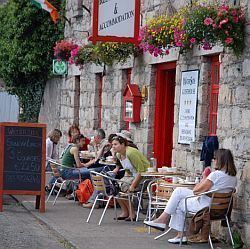Country Ireland Irish Grid Reference S705440 Local time Saturday 2:32 AM | Elevation 32 m | |
 | ||
Weather 12°C, Wind W at 32 km/h, 86% Humidity | ||
Graiguenamanagh or Graignamanagh (Irish: Gráig na Manach, meaning "village of the monks") is a town in County Kilkenny, Ireland. It is located on the R705 regional road by the border with County Carlow on the River Barrow at the foot of Brandon Hill. It is home to Duiske Abbey, the largest and perhaps the finest of the thirty-four medieval Cistercian abbeys in Ireland.
Contents
Map of Graiguenamanagh, Co. Kilkenny, Ireland
Public transport
Kilbride Coaches operate a route linking the town to Kilkenny via Gowran.
History
The River Barrow, historically a significant highway, was developed as a commercial navigation in the mid seventeen hundreds and Graiguenamanagh served as the main base for commercial barges operating on the river until barge traffic ceased in 1959. The barges that at one time lined the quaysides are now replaced by some one hundred pleasure craft.
Near to the town are the ruined remains of the early Christian church of Ullard, founded by Saint Fiachra in the seventh century. St Fiachra subsequently moved to France, where he is known as St Fiacre, and founded the celebrated monastery at Meaux. He is the patron saint of gardeners and taxi drivers; French cabs are often known as fiacres in his honour. Some few miles downstream from Graiguenamanagh the ruins of the ancient monastic establishment at St. Mullins are situated in an area of great beauty and historic interest.
Recreation
Walking, cycling and watersports are among the more popular pursuits of Graiguenamanagh area and with the South Leinster Way meandering through the lovely Barrow Valley and traversing nearby Brandon Hill, scope is provided for a gentle stroll or a vigorous, day-long hike. The Barrow's aquatic facilities include fishing, swimming, kayaking and canoeing. Graigue, as the town is popularly known, is home to a rowing club, a canoe club, an athletics club, the G.A.A(Hurling and Gaelic football) and a soccer club, Highview Athletic.
In the centre of the town, its handsome modern library features a comprehensive Local History Section. It provides an Internet Service to the public and, in addition to its other functions, hosts periodic art exhibitions. The very active Graiguenamanagh Historical Society also sponsor a series of talks and lectures at this venue during the winter season. Adjacent to the library is The Abbey Centre, the home of a Christian Art Gallery and small museum. Here also for the genealogically inclined may be perused the Graiguenamanagh Parish Birth and Marriage Registers.
Duiske Abbey
The Duiske Abbey, which takes its name from the little river Duiske (Blackwater) which joins the Barrow here, was founded by William Marshall in 1204 and was suppressed by Henry VIII in 1536. Significant remains of the monastery exist to the rear of the houses that line the east side of Lower Main Street. The abbey's large "Early English" gothic church, was restored in the 1970s and in its northern aisle a model shows the monastery as it was in the fourteenth century.
